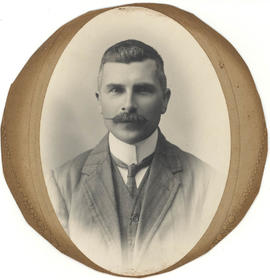Joan Wendoline Clark grew up in Kincardineshire and Sussex. Fluent in French and German, skilled in shorthand and a trained typist, she worked for a time at the Foreign Office in London and at the British Embassy in Paris. In the 1930s she returned with her husband to Scotland and together they settled in Lochaber, where she remained until her death on 6 July 1999. Shortly after her death, her daughter gifted Joan’s manuscript collection to the University of Edinburgh's School of Scottish Studies Archives. That collection includes her correspondence and botanical research notes dating from the 1970s right up until 1999, along with three specimen books containing almost 350 pressed wildflowers collected around Onich, Ballachulish, North Uist and Glencoe in around 1976. (from Elaine MacGillivray's blog SSSA in 70 objects: Filling the Creative Well: A Tribute to Joan W. Clark - (right click, open link in new tab: https://libraryblogs.is.ed.ac.uk/sssa/object19/ )) Three foolscap hortus siccus scrapbooks comprising Clark's Taraxacum collection has come to RBGE. D McKean has removed some of these specimens to add to the herbarium collection, but the remainder, still in the scrapbooks, was transferred to the Library's Hortus Siccus collection in April 2023.
Bertha Chandler (Mrs. C. Norman Kemp) was the first woman to obtain the degree of D.Sc. of Edinburgh University July 1915.
Born 1872; died 1965. Plant collector
George Cave trained as a Kew gardener, graduating in 1895. In 1896 he became assistant at the Botanic Gardens, Calcutta and in 1900 was appointed Governor of the Cinchona Plantations, Mungpoo (Bengal). In 1904 he became curator of the Lloyd Botanic Garden, Darjeeling. He went on numerous plant collecting tours in Tibet, Nepal and Sikkim and some diaries from these tours are held by the Royal Botanic Garden Edinburgh.
Sources: Desmond; Rowena Cave, ‘George Cave’s Diary, Sikkim 1906’.
D.W.
W.H. Campbell was a student of Robert Graham and one of the founding members of the Botanical Society of Edinburgh in 1836, becoming its first Secretary.
Amy N. Cameron has been identified as the regular photographer of MacWatt’s collection of Primulas and other items in his horticultural collection, and responsible for the illustrations in his publications.
Amelia Nisbet Cameron was born at Trinity Lodge in Duns, Berwickshire on 21 October 1871 to the late Rev Daniel Cameron (1840 -1871) and Elizabeth Waller Dowling Brown (1842-1879). Daniel, Minister of Ayton Parish Church had died on 3 June. Elizabeth remarried on 28 June 1875, to William George Dunlop (Scotsman 29 June 1875, p8) but died 4 years later.
In 1891, Amelia, now aged 19, is listed in the census with her elder sister Elizabeth Waller Cameron (1869 -1955), aged 21, as living with their great-aunt Margaret Stuart Brown, aged 68, sister of their maternal grandfather Forbes Scott Brown (1816-1874). Along with 7 Brown relatives and 8 live-in servants, their residence was Nisbet House, the castle/mansion at Edrom. Both young women were described as 'living on independent means'. As they had lost both their parents when small, Margaret Brown may have had a leading part in their up-bringing.
By the time of the 1901 census, Amelia, with her great-aunt and 3 servants, is recorded as living again in the place of her birth, - Trinity Lodge, a respectable but less magnificent residence, long in the hands of the Brown family. It seems that Trinity Lodge remained Amelia's home for the rest of her life. In his 1923 monograph on 'The Primulas of Europe', Dr John MacWatt refers to her as Miss Amy N. Cameron of Trinity, Duns. At 'Morelands' in Station Road, Duns, his married home with extensive gardens, MacWatt would have been a near neighbour.
In 1923 Dr John MacWatt publishes ‘The Primulas of Europe’ with 41 black and white and 8 coloured illustrations. In the introduction (vi) he states: ‘My thanks are also due to Miss Amy Cameron, Trinity, Duns, for the generous way in which she has expended time and labour in the photographs which add so greatly to the value of the book’. Some of these, published earlier, were among figs 25-40 illustrating his 1913 paper to the Third Primula Conference and/or were among the MacWatt prints dated 1913 in the RBGE collection, confirming that Amy was already his regular plant photographer by this date.
When interviewed in April 2023, Mrs Elizabeth Farquharson, MacWatt’s youngest child, then aged 107, had clear memories of Amy. She described her as shorter and stouter than her elder sister. Although she was artistic and sometimes tinted her prints, it was for her accuracy that MacWatt particularly appreciated her work. Amy apparently had no interest in selling her prints and rarely even signed them.
In New Flora and Silva, Vol 2, No 2 (January 1930), 111-112, Amy Cameron provided a note, illustrated with a photograph (Fig xxxv) on ‘Digitalis dubia’ in the New and Interesting Plants section. She describes and comments on the performance of this perennial foxglove from the Balearic Islands, which she has grown from seed. ‘The Foxglove in the accompanying picture is growing at the top of a miniature cliff, with Erica vagans St. Kerverne growing near it’. This implies that a year before her death she was still active as a photographer, and was herself a knowledgeable horticulturist.
Amy Nisbet Cameron died on 19 April 1931. A report of her funeral appeared in Berwickshire News and Advertiser 28 April 1931, p6; the pall bearers listed included her sister, Dr MacWatt, and Mr George Hume, gardener, Trinity.
Biography by Dr. Helen Bennett
